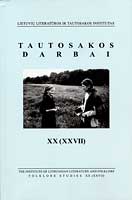Interneto folkloras: rūšis ar sklaidos būdas?
Internet folklore: separate kind or mere means of dissemination?
Author(s): Povilas KrikščiūnasSubject(s): Customs / Folklore
Published by: Lietuvių literatūros ir tautosakos institutas
Keywords: Post folklore; internet; dissemination
Summary/Abstract: Subject of the article is folklore and various folklore-related texts, appearing on the internet site www.omni.lt or disseminated by e-mail. They are compared to the SMS messages and texts published in periodicals. Ways of their dissemination and connections to the individual oeuvre as well as traditional folklore are also investigated. The aim is finding out whether this material is actually new, what social strata it is popular in, and whether it is justly labeled as “internet folklore”. The author concludes this phenomenon to reflect ways of life of various social groups, having access to internet, characterized by all the peculiarities of post-folklore. Internet becomes means of folklore dissemination, just like oral or written tradition. Pieces discussed here are disseminated in oral and written form, through media, via internet and by SMS messages. Consequently, they should not be regarded as belonging exclusively to internet folklore. Only jokes requiring use of Multimedia or special computer programs could be labeled as such. The majority of the analyzed examples belong to the comic folklore. They can be of two kinds: folkloric pieces of literary origin (not necessarily Lithuanian) and actualized traditional folklore. Travesties or contaminations of the latter, in order to achieve comical effect, are especially popular.
Journal: Tautosakos darbai
- Issue Year: 2004
- Issue No: 27
- Page Range: 20-27
- Page Count: 8
- Language: Lithuanian

